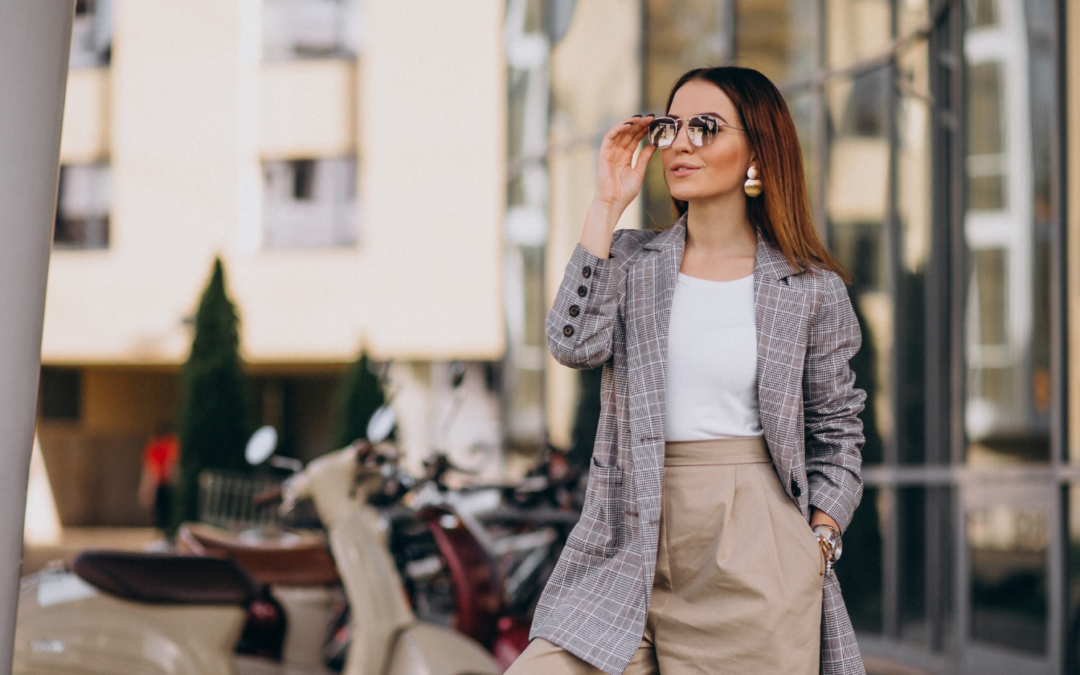Dressing for work used to be simple: put on a suit, shine your shoes, and you were ready to go. But times have changed, and so have the rules.
What you wear to work today isn’t just about looking polished; it’s about projecting confidence, aligning with your brand, and feeling good in your own skin.
The truth is that what we wear impacts how others perceive us and even how we see ourselves. And while “power dressing” might sound old-school, it’s still very much alive—just with a modern twist.
It’s no longer about rigid dress codes; it’s about intention and authenticity.
In this article, I’ll walk you through the seven new rules of power dressing at work.
Whether you’re leading a meeting or brainstorming with your team, these updated guidelines will help you show up as your best self—without losing sight of who you are. Let’s dive in!
1) Dress for the role you have—and the one you want
Most people have heard the phrase “dress for the job you want, not the job you have.” While it’s a little cliché, there’s truth to it—but with a modern twist.
In today’s workplace, it’s not just about looking the part; it’s about dressing in a way that aligns with your goals and how you want to be perceived.
Power dressing today means finding a balance between professionalism and authenticity.
If you’re aiming for a leadership role, think about what leaders in your field wear—and how you can adapt that style to reflect your own personality.
You don’t have to copy anyone else; instead, use their approach as inspiration to craft your own confident, polished look.
Remember, your clothes send a message before you even speak. Dressing intentionally can help bridge the gap between where you are now and where you’re headed next.
2) Prioritize comfort without sacrificing professionalism
I’ll admit, I used to think that “power dressing” meant stiff blazers, uncomfortable shoes, and clothes that felt more like armor than anything I actually wanted to wear.
But one day, during a particularly long workday filled with back-to-back meetings, I realized something: I couldn’t focus because all I could think about was how my feet were killing me and how tight my shirt felt.
I looked polished, sure, but I definitely didn’t feel powerful.
That’s when I made a shift. I started investing in pieces that not only looked professional but also felt great to wear.
For example, I found tailored pants with stretch fabric and swapped hard-to-walk-in heels for sleek flats.
The result? I felt more confident because I wasn’t distracted by discomfort—and people started noticing how much more present and energized I seemed.
Power dressing doesn’t mean you have to suffer for style. When you feel good in what you’re wearing, it shows in your posture, your focus, and even the way you carry yourself in the room.
Trust me, comfort and professionalism can absolutely go hand in hand.
3) Use color to convey confidence and intention
What you wear isn’t just about the cut and fit—it’s also about the colors you choose.
Colors have a psychological impact, not just on others but on yourself too.
For example, blue is often associated with trust and reliability, which is why it’s a favorite for business settings.
Red, on the other hand, signals confidence and energy, making it a great choice for presentations or moments when you want to stand out.
Interestingly, even neutral tones like black, gray, and white can make a statement. Black exudes authority, while gray suggests balance and professionalism.
The key is to think about the message you want to send and let your clothing reflect that.
By being intentional with your color choices, you can subtly influence how others perceive you before you even say a word.
4) Invest in quality over quantity
In the age of fast fashion, it’s tempting to fill your wardrobe with trendy, inexpensive pieces. But when it comes to power dressing, less is often more.
A few high-quality, well-tailored items will always outshine a closet full of cheaply made clothes that don’t hold up over time.
Think about it: a perfectly tailored blazer or a classic pair of leather shoes can elevate even the simplest outfit. Not only do quality pieces last longer, but they also give off an air of sophistication and care.
People notice the details—how your clothes fit, how they move with you, and even how they feel in a handshake or greeting.
Building a wardrobe of timeless, durable pieces might take longer upfront, but it’s an investment that pays off every time you step into the room looking polished and put-together.
5) Embrace your individuality
For a long time, I thought blending in was the safest route. I stuck to neutral tones, avoided bold patterns, and dressed exactly how I thought everyone else expected me to.
But over time, I started to feel like I was losing a part of myself. My clothes didn’t reflect who I was—they just made me feel invisible.
Eventually, I started adding small touches that felt more “me,” like a patterned scarf or a pair of statement shoes.
At first, it felt risky, but something surprising happened: people responded.
Colleagues complimented my choices, and I felt more confident walking into the office because my wardrobe finally aligned with who I really was.
Power dressing isn’t about fitting into a mold; it’s about standing out in a way that feels authentic.
When you let your individuality shine through—even in subtle ways—you’ll not only feel more comfortable in your own skin, but you’ll leave an impression that’s impossible to forget.
6) Pay attention to the details
It’s easy to focus on the big pieces of your outfit—a blazer, a dress, or a pair of trousers—and overlook the smaller details.
But sometimes, it’s the little things that make the biggest difference.
Scuffed shoes, wrinkled clothes, or an ill-fitting jacket can unintentionally send the message that you’re not paying attention, even if you’re highly capable.
Things like keeping your shoes polished, ensuring your clothes are pressed, and choosing accessories that complement rather than distract can elevate your entire look.
Even something as simple as a well-chosen watch or a belt that matches your shoes can pull everything together effortlessly.
Details show care and thoughtfulness, and in a professional setting, they matter more than you might realize.
When every part of your outfit is intentional, it signals that you’re someone who pays attention—not just to your wardrobe but to everything you do.
7) Let your confidence be your best accessory
No matter what you wear, the most important element of power dressing is how you carry yourself.
Even the most perfectly tailored outfit won’t make an impact if you’re slouched, avoiding eye contact, or hesitant in your movements. Confidence isn’t just visible—it’s contagious.
The key is to wear clothes that make you feel strong and authentic. When you feel good in what you’re wearing, it shows in the way you walk, speak, and engage with others.
People are drawn to confidence, and the right outfit can help amplify it—but it has to start from within.
Bottom line: It’s about more than clothes
The way we dress for work is about so much more than fabric, colors, or trends—it’s a form of nonverbal communication.
Your outfit speaks before you do, shaping the way others perceive you and, just as importantly, how you perceive yourself.
Research has shown that what we wear can influence our confidence, decision-making, and even how we approach challenges.
Power dressing isn’t about rigid rules or outdated standards; it’s about understanding who you are and where you’re headed—and reflecting that in the way you present yourself.
When your clothing aligns with your intentions and values, it becomes a tool for empowerment, not just a daily task.
At the end of the day, the most powerful thing you can wear is a quiet certainty in who you are and what you stand for.









